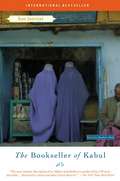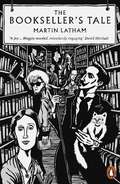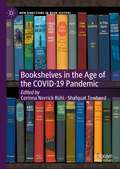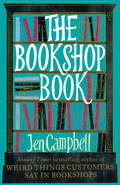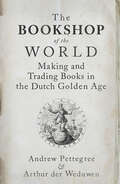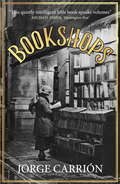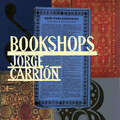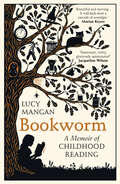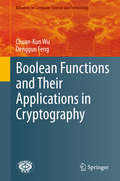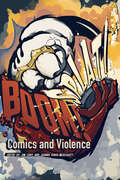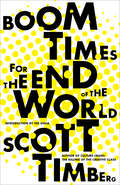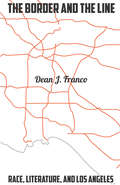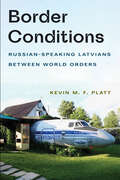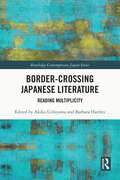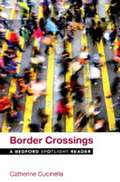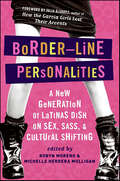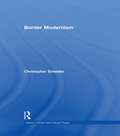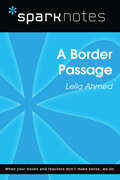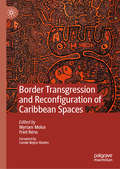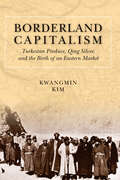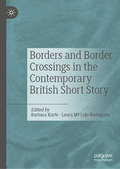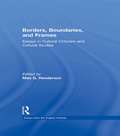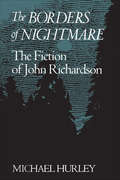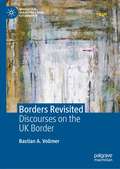- Table View
- List View
The Bookseller of Kabul
by Asne Seierstad Ingrid ChristophersenAn unusually intimate glimpse of a typical Afghan family, gleaned from the author's 3-month stay with the bookseller's family. With a list of questions for reading groups.
The Bookseller's Tale
by Martin LathamA SPECTATOR AND EVENING STANDARD BOOK OF THE YEAR 2020'A joy. Each chapter instantly became my favourite' David Mitchell, author of Cloud Atlas'Wonderful' Lucy Mangan'The right book has a neverendingness, and so does the right bookshop.'This is the story of our love affair with books, whether we arrange them on our shelves, inhale their smell, scrawl in their margins or just curl up with them in bed. Taking us on a journey through comfort reads, street book stalls, mythical libraries, itinerant pedlars, radical pamphleteers, extraordinary bookshop customers and fanatical collectors, Canterbury bookseller Martin Latham uncovers the curious history of our book obsession - and his own. Part cultural history, part literary love letter and part reluctant memoir, this is the tale of one bookseller and many, many books.'If ferreting through bookshops is your idea of heaven, you'll get the same pleasure from this treasure trove of a book' Jake Kerridge, Sunday Express
Bookshelves in the Age of the COVID-19 Pandemic (New Directions in Book History)
by Corinna Norrick-Rühl Shafquat TowheedBookshelves in the Age of the COVID-19 Pandemic provides the first detailed scholarly investigation of the cultural phenomenon of bookshelves (and the social practices around them) since the start of the pandemic in March 2020. With a foreword by Lydia Pyne, author of Bookshelf (2016), the volume brings together 17 scholars from 6 countries (Australia, Canada, Germany, the Netherlands, the UK, and the USA) with expertise in literary studies, book history, publishing, visual arts, and pedagogy to critically examine the role of bookshelves during the current pandemic. This volume interrogates the complex relationship between the physical book and its digital manifestation via online platforms, a relationship brought to widespread public and scholarly attention by the global shift to working from home and the rise of online pedagogy. It also goes beyond the (digital) bookshelf to consider bookselling, book accessibility, and pandemic reading habits.
The Bookshop Book
by Jen CampbellWe're not talking about rooms that are just full of books. We're talking about bookshops in barns, disused factories, converted churches and underground car parks. Bookshops on boats, on buses, and in old run-down train stations. Fold-out bookshops, undercover bookshops, this-is-the-best-place-I've-ever-been-to-bookshops. Meet Sarah and her Book Barge sailing across the sea to France; meet Sebastien, in Mongolia, who sells books to herders of the Altai mountains; meet the bookshop in Canada that's invented the world's first antiquarian book vending machine. And that's just the beginning. From the oldest bookshop in the world, to the smallest you could imagine, The Bookshop Book examines the history of books, talks to authors about their favourite places, and looks at over three hundred weirdly wonderful bookshops across six continents (sadly, we've yet to build a bookshop down in the South Pole). The Bookshop Book is a love letter to bookshops all around the world. --"A good bookshop is not just about selling books from shelves, but reaching out into the world and making a difference." David Almond (The Bookshop Book includes interviews and quotes from David Almond, Ian Rankin, Tracy Chevalier, Audrey Niffenegger, Jacqueline Wilson, Jeanette Winterson and many, many others.)
The Bookshop of the World: Making and Trading Books in the Dutch Golden Age
by Andrew Pettegree Arthur der WeduwenThe untold story of how the Dutch conquered the European book market and became the world’s greatest bibliophiles.The Dutch Golden Age has long been seen as the age of Rembrandt and Vermeer, whose paintings captured the public imagination and came to represent the marvel that was the Dutch Republic. Yet there is another, largely overlooked marvel in the Dutch world of the seventeenth century: books.In this fascinating account, Andrew Pettegree and Arthur der Weduwen show how the Dutch produced many more books than pictures and bought and owned more books per capita than any other part of Europe. Key innovations in marketing, book auctions, and newspaper advertising brought stability to a market where elsewhere publishers faced bankruptcy, and created a population uniquely well-informed and politically engaged. This book tells for the first time the remarkable story of the Dutch conquest of the European book world and shows the true extent to which these pious, prosperous, quarrelsome, and generous people were shaped by what they read.“Book history at its best.” —Robert Darnton, New York Review of Books“Compelling and impressive.” —THES (Book of the Week)“An instant classic on Dutch book history.” —BMGN - Low Countries Historical Review
Bookshops
by Jorge Carrión"A lot of people will be interested in the famous bookshops of the world: Jorge Carrión has gone and visited them all. We can't travel right now, but we can travel in books." MARGARET ATWOODWhy do bookshops matter? How do they filter our ideas and literature? In this inventive and highly entertaining extended essay, Jorge Carrion takes his reader on a journey around the world, via its bookshops. His travels take him to Shakespeare & Co in Paris, Wells in Winchester, Green Apple Books in San Francisco, Librairie des Colonnes in Tangier, the Strand Book Store in New York and provoke encounters with thinkers, poets, dreamers, revolutionaries and readers. Bookshops is the travelogue of a lucid and curious observer, filled with anecdotes and stories from the universe of writing, publishing and selling books. A bookshop in Carrion's eyes never just a place for material transaction; it is a meeting place for people and their ideas, a setting for world changing encounters, a space that can transform lives.Written in the midst of a worldwide recession, Bookshops examines the role of these spaces in today's evershifting climate of globalisation, vanishing high streets, e-readers and Amazon. But far from taking a pessimistic view of the future of the physical bookshop, Carrion makes a compelling case for hope, underlining the importance of these places and the magic that can happen there. A vital manifesto for the future of the traditional bookshop, and a delight for all who love them.Translated from the Spanish by Peter Bush
Bookshops
by Jorge CarriónWhy do bookshops matter? How do they filter our ideas and literature? In this inventive and highly entertaining extended essay, Jorge Carrion takes his reader on a journey around the world, via its bookshops. His travels take him to Shakespeare & Co in Paris, Wells in Winchester, Green Apple Books in San Francisco, Librairie des Colonnes in Tangier, the Strand Book Store in New York and provoke encounters with thinkers, poets, dreamers, revolutionaries and readers. Bookshops is the travelogue of a lucid and curious observer, filled with anecdotes and stories from the universe of writing, publishing and selling books. A bookshop in Carrion's eyes never just a place for material transaction; it is a meeting place for people and their ideas, a setting for world changing encounters, a space that can transform lives.Written in the midst of a worldwide recession, Bookshops examines the role of these spaces in today's evershifting climate of globalisation, vanishing high streets, e-readers and Amazon. But far from taking a pessimistic view of the future of the physical bookshop, Carrion makes a compelling case for hope, underlining the importance of these places and the magic that can happen there. A vital manifesto for the future of the traditional bookshop, and a delight for all who love them.(P)2016 WF Howes Ltd
The Bookstore Cat
by Cylin BusbyAn irresistible and engaging picture book perfect for story time, and for cat and bookstore lovers alike! The bookstore cat is an adorable . . . bossy . . . cuddly cat. He is everything from intelligent and loyal to naughty and vocal! But most of all, the bookstore cat is a well-loved (and well-read) kitty. Follow his funny antics from A to Z through a day in his bustling, book-filled shop. The Bookstore Cat is based on a Victorian parlor game, The Minister’s Cat, in which players try to think of adjectives to describe the cat in alphabetical order. Readers can extend the fun of the book by playing their own version of the game.
Bookworm: A Memoir of Childhood Reading
by Lucy ManganA love letter to the joys of childhood reading from Wonderland to Narnia.When Lucy Mangan was little, stories were everything. They opened up new worlds and cast light on all the complexities she encountered in this one.She was whisked away to Narnia - and Kirrin Island - and Wonderland. She ventured down rabbit holes and womble burrows into midnight gardens and chocolate factories. She wandered the countryside with Milly-Molly-Mandy, and played by the tracks with the Railway Children. With Charlotte's Web she discovered Death and with Judy Blume it was Boys. No wonder she only left the house for her weekly trip to the library or to spend her pocket money on amassing her own at home.In Bookworm, Lucy revisits her childhood reading with wit, love and gratitude. She relives our best-beloved books, their extraordinary creators, and looks at the thousand subtle ways they shape our lives. She also disinters a few forgotten treasures to inspire the next generation of bookworms and set them on their way.Lucy brings the favourite characters of our collective childhoods back to life - prompting endless re-readings, rediscoveries, and, inevitably, fierce debate - and brilliantly uses them to tell her own story, that of a born, and unrepentant, bookworm.'Passionate, witty, informed, and gloriously opinionated' Jacqueline Wilson author of The Story of Tracy Beaker
Boolean Functions and Their Applications in Cryptography (Advances in Computer Science and Technology #0)
by Chuan-Kun Wu Dengguo FengThis book focuses on the different representations and cryptographic properties of Booleans functions, presents constructions of Boolean functions with some good cryptographic properties. More specifically, Walsh spectrum description of the traditional cryptographic properties of Boolean functions, including linear structure, propagation criterion, nonlinearity, and correlation immunity are presented. Constructions of symmetric Boolean functions and of Boolean permutations with good cryptographic properties are specifically studied. This book is not meant to be comprehensive, but with its own focus on some original research of the authors in the past. To be self content, some basic concepts and properties are introduced. This book can serve as a reference for cryptographic algorithm designers, particularly the designers of stream ciphers and of block ciphers, and for academics with interest in the cryptographic properties of Boolean functions.
BOOM! SPLAT!: Comics and Violence
by Jim Coby and Joanna Davis-McElligattContributions by Lawrence Abrams, Diana Álvarez Amell, Partha Bhattacharjee, Natalja Chestopalova, Jim Coby, Rita Costello, Sam Cowling, Joanna Davis-McElligatt, Elisabetta Di Minico, Kiera M. Gaswint, Vincent Haddad, Kaleb Knoblauch, Christina M. Knopf, Leah Milne, Jacob Murel, Priyanka Tripathi, and Steven S. Vrooman In 1954, the culture, distribution, and content of comics forever changed. Long a mainstay of America’s reading diet, comic books began to fall under the scrutiny of parent groups, church leaders, and politicians. The bright colors and cheaply printed pulp pages of comic books that had once provided an escape were suddenly presumed to house something lascivious, insidious, and morally corrosive. While anxieties about representations of violence in comics have largely fallen to the wayside since the moral panic of the 1950s, thematic and symbolic visual depictions of violence remain central to the comics form. BOOM! SPLAT! Comics and Violence examines violence in every iteration—physical violence enacted between people and their environments, formal and structural violence embedded in the comics language itself, representations of historical violence, and ways of reading and seeing violence.BOOM! SPLAT! is composed of fifteen essays from renowned comics scholars and is organized thematically into four sections, including an examination of histories of violence, forms of violence, modes and systems of violence, and political and social violence. Chapters focus on well-known comics and comics creators, such as Steve Ditko, Hulk, X-Men, and the Marvel universe, to newspaper cartoon strips, postwar graphic novels, revolution, civil rights, trauma, #blacklivesmatter, and more. BOOM! SPLAT! serves as a resource to scholars and comics enthusiasts who wish to contemplate and confront the permutations, forms, structures, and discourses of violence that have always animated cartoons. Through this interrogation, our understanding of violence moves beyond the immediately physical and interpersonal into modes of ephemeral, psychological, and ideological violence. Contributors fill critical gaps by offering sustained explorations of the function of manifold violences in the comics language—those seen, felt, and imagined. The essays in this collection are critically necessary for understanding the current and historical role that violence has played in comics and will help recognize how cartooning imbricates, resists, and expands our thinking about and experiences of violence.
Boom Times for the End of the World
by Scott TimbergA rich banquet at the cutting edge of the arts, rooted in California’s eclectic cultural gumbo, by one of America’s most gifted critics, who died young in 2019."A perfect journalistic valediction from one of LA’s finest commentators."—Richard ThompsonThe late Scott Timberg championed artists earnestly and relentlessly, with empathy and persistence. He was a vocal and widely admired advocate for working artists, one of the first to sound the alarm on the escalating economic challenges that have faced creative workers in the twenty-first century. The twenty-six reflections in this book form a valuable window onto many cultural shifts that have upended the country’s creative traditions and expectations. They are, by turns, surprising, wide-ranging, passionate, and fun. Timberg’s perceptive and enthusiastic profiles on the arts extend to West Coast jazz and Gustavo Dudamel’s LA Philharmonic, the fiction of Ray Bradbury and John Rechy, the early films of Spike Jonze and Christopher Nolan, the comics of Los Bros Hernandez and Adrian Tomine, and many more musicians, novelists, filmmakers, architects, and impresarios. Timberg had a knack, as Ted Gioia writes in his introduction, for “finding the best in the cultural scene on the dream coast.” This is an indispensable volume that showcases the author’s endless curiosity, as well as his passion and love for California—especially that confounding and complex metropolis Los Angeles.
The Border and the Line: Race, Literature, and Los Angeles (Stanford Studies in Comparative Race and Ethnicity)
by Dean J. FrancoLos Angeles is a city of borders and lines, from the freeways that transect its neighborhoods to streets like Pico Boulevard that slash across the city from the ocean to the heart of downtown, creating both ethnic enclaves and pathways for interracial connection. Examining neighborhoods in east, south central, and west L.A.—and their imaginative representation by Chicana, African American, and Jewish American writers—this book investigates the moral and political implications of negotiating space. The Border and the Line takes up the central conceit of "the neighbor" to consider how the geography of racial identification and interracial encounters are represented and even made possible by literary language. Dean J. Franco probes how race is formed and transformed in literature and in everyday life, in the works of Helena María Viramontes, Paul Beatty, James Baldwin, and the writers of the Watts Writers Workshop. Exploring metaphor and metonymy, as well as economic and political circumstance, Franco identifies the potential for reconciliation in the figure of the neighbor, an identity that is grounded by geographical boundaries and which invites their crossing.
Border Conditions: Russian-Speaking Latvians between World Orders (NIU Series in Slavic, East European, and Eurasian Studies)
by Kevin M. PlattBorder Conditions combines history and memory studies with literary and cultural studies to examine lives at the limits of contemporary Europe: Russian speakers living in Latvia. Since the fall of the USSR in 1991, Latvia's Russian speakers have balanced between Russia and Europe as well as a socialist past, a capitalist and liberal present, and an illiberal regime rising in the Russian Federation. Kevin M. F. Platt describes how members of this population have defined themselves through art, literature, cultural institutions, film, and music—and how others have sought to define them. At the end of the Cold War, many anticipated that societies globally could agree on the meaning of past history and a just politics in the present. The view from the borders of Europe demonstrates the contradictions pertaining to terms like empire, state socialism, liberalism, and nation that have made it impossible to achieve a consensus. In refocusing the examination of state socialism's aftermath around questions of empire and postcolonialism, Border Conditions helps us understand the distinctions between Russian and Western worldviews driving military confrontation to this day.
Border-Crossing Japanese Literature: Reading Multiplicity (Routledge Contemporary Japan Series)
by Akiko Uchiyama Barbara HartleyThis collection focuses on metaphorical as well as temporal and physical border-crossing in writing from and about Japan. With a strong consciousness of gender and socio-historic contexts, contributors to the book adopt an intercultural and interdisciplinary approach to examine the writing of authors whose works break free from the confines of hegemonic Japanese literary endeavour. By demonstrating how the texts analysed step outside the space of ‘Japan’, they accordingly foreground the volatility of textual expression related to that space. Authors discussed include Takahashi Mutsuo and Nagai Kafū, both of whom take literary inspiration from geographical sites outside Japan Several chapters examine the work of exemplar border-crossing poet, novelist and essayist, Itō Hiromi. There are discussions of the work of Tawada Yōko whose ability to publish in German and Japanese marks her also as a representative writer of border-crossing texts. Two chapters address works by Murakami Haruki who, although clearly affiliating with western cultural form, is rarely discussed in specific border-crossing terms. The chapter on Ainu narratives invokes topics such as translation, indigeneity and myth, while an analysis of Japanese prisoner of war narratives notes the language and border-crossing nexus. A vital collection for scholars and students of Japanese literature.
Border Crossings: A Bedford Spotlight Reader
by Catherine CucinellaDelving into questions like, "What are borders?" and "Who are border crossers?", Border Crossings breaks down the complex issue through an extensive variety of readings and activities to really get you thinking and evaluating this theme.
Border-Line Personalities: A New Generation of Latinas Dish on Sex, Sass, & Cultural Shifting
by Robyn Moreno and Michelle Herrera MulliganA collection of essays from some of the best writers in America, about what it means to be a fully functional, and sometimes fully dysfunctional, 21st–century, born–in–the–USA LatinaTired of the trite cultural clichés by which the media has defined Latinas, the editors of this collection of personal essays by both established and emerging authors, have gathered them with the intention of representing their varied experiences, through hilarious anecdotes from each of their colorful lives. While there is no one Latina identity, the editors believe that by offering a glimpse into these writers’ dynamic lives, they will facilitate a better understanding of their unique challenges and their dreams, and most important, their oftentimes shared histories.The contributors to this collection mirror the compassionate pleas Latinas usually reserve for each other over conversations in dark bars and late night gatherings. “Do they have to think that just because I’m a Latina that I can speak Spanish, curl my hair, paint my toe nails, and dance a rumba--all at the same time?” This, along with other interesting questions, results in a spectacular line up that has Latinas musing on their battling the world, the men that have done them wrong, and of course the mothers who, more often than not, just never understood that their daughters were more Americanas than not.
Border Modernism: Intercultural Readings In American Literary Modernism (Literary Criticism and Cultural Theory)
by Christopher SchedlerReorienting the field of American literary modernism, Christopher Schedler defines an intercultural form of representation termed border modernism that challenges the aesthetic hegemony of metropolitan (high) modernism. In this study, Schedler compares the works of European and Anglo-American modernists with the works of Mexican, Native American, and Chicano writers who engaged with modernist theories and practices. In the process he uncovers a unique intercultural aesthetic produced in the borderlands of the United States and Mexico aimed at modernizing the native literary traditions of the Americas. Addressing issues of migration, cultural identity, and ethnography, Border Modernism is a major contribution to current debates over the origins and development of American literary modernism and a new model for transnational and intercultural reconstructions of American literary history.
A Border Passage (SparkNotes Literature Guide Series)
by SparkNotesA Border Passage (SparkNotes Literature Guide) by Leila Ahmed Making the reading experience fun! Created by Harvard students for students everywhere, SparkNotes is a new breed of study guide: smarter, better, faster.Geared to what today's students need to know, SparkNotes provides:chapter-by-chapter analysis explanations of key themes, motifs, and symbols a review quiz and essay topicsLively and accessible, these guides are perfect for late-night studying and writing papers.
Border Transgression and Reconfiguration of Caribbean Spaces
by Myriam Moïse Fred RénoA dividing line, the border is usually perceived in terms of separation and rupture. It is a site of tension par excellence, at the origin of contestations, negotiations, and other conflicting patterns of inclusion/exclusion. This book takes us through an exploration of the border in the Caribbean region, both geographically fragmented and strongly tied through its history, culture and people. This collection of scholarly articles interrogates the border within the specificities of the Caribbean context, its socio-political dynamics and its literary and artistic representations. The transgression of borders and the consequent reconfiguring phenomena are thus applied to the Caribbean and its diasporas, through a transdisciplinary approach. The book combines a multiplicity of research fields, including Social Sciences, Cultural Geography, Geopolitics, Cultural and Literary Studies, hence it offers a global perspective on the topic and transcends disciplinary categories. The contents of the book also stretch beyond geographic and linguistic borders as the contributors come from diverse scholarly backgrounds, affiliations, linguistic areas, and research expertise.
Borderland Capitalism: Turkestan Produce, Qing Silver, and the Birth of an Eastern Market
by Kwangmin KimScholars have long been puzzled by why Muslim landowners in Central Asia, called begs, stayed loyal to the Qing empire when its political legitimacy and military power were routinely challenged. Borderland Capitalism argues that converging interests held them together: the local Qing administration needed the Turkic begs to develop resources and raise military revenue while the begs needed access to the Chinese market. Drawing upon multilingual sources and archival material, Kwangmin Kim shows how the begs aligned themselves with the Qing to strengthen their own plantation-like economic system. As controllers of food supplies, commercial goods, and human resources, the begs had the political power to dictate the fortunes of governments in the region. Their political choice to cooperate with the Qing promoted an expansion of the Qing's emerging international trade at the same time that Europe was developing global capitalism and imperialism. Borderland Capitalism shows the Qing empire as a quintessentially early modern empire and points the way toward a new understanding of the rise of a global economy.
Borders and Border Crossings in the Contemporary British Short Story
by Barbara Korte Laura Mª Lojo-RodríguezThis book represents a contribution to both border studies and short story studies. In today’s world, there is ample evidence of the return of borders worldwide: as material reality, as a concept, and as a way of thinking. This collection of critical essays focuses on the ways in which the contemporary British short story mirrors, questions and engages with border issues in national and individual life. At the same time, the concept of the border, as well as neighbouring notions of liminality and intersectionality, is used to illuminate the short story’s unique aesthetic potential. The first section, “Geopolitics and Grievable Lives”, includes chapters that address the various ways in which contemporary stories engage with our newly bordered world and borders within contemporary Britain. The second section examines how British short stories engage with “Ethnicity and Liminal Identities”, while the third, “Animal Encounters and Metamorphic Bodies”, focuses on stories concerned with epistemological borders and borderlands of existence and identity. Taken together, the chapters in this volume demonstrate the varied and complex ways in which British short stories in the twenty-first century engage with the concept of the border.
Borders, Boundaries, and Frames (Essays from the English Institute)
by Mae G. HendersonThe essays in this volume take up the challenge of working out -- or reworking -- the problematics of the borders, the boundaries and the frameworks that structure our various and multiple notions of identity -- textual, personal, collective, generic, and disciplinary. The contributors to this volume write about subjects (and are often themselves subjects) who "refuse to occupy a single territory" -- who cross geographical, cultural, national, linguistic, generic, specular and disciplinary borders. Essays by Kathryn Hellerstein, Anita Goldman, Jane Marcus and Scott Malcomson exlpore the semiotics of exile and the problem of its representation in the lives and writings of individual aritists and intellectuals. Autobiographical criticism, as represented in the essays by Nancy Miller and Sara Suleri, enlargess our conventional notions of what consitutes literature in general and criticism in particular.
The Borders of Nightmare: The Fiction of John Richardson
by Michael HurleyJohn Richardson was Canada's first native-born poet-novelist and 'The Father of Canadian Literature.' Michael Hurley offers the first detailed account of Richardson's fiction rather than of his life or sociological importance. Hurley makes a convincing case for Richardson as an important early cartographer of the Canadian imagination and the originator of 'Southern Ontario Gothic.' He explores Richardson's influence on James Reaney, Alice Munro, Robertson Davies, Christopher Dewdney, Frank Davey, and Marian Engel. Arguing that Wacousta and The Canadian Brothers hold central places in our literature, Hurley shows how these two works established a set of boundaries that our national literary discourse has largely kept hidden. Focusing on the protean concept of the border in the fiction of this man from the periphery, The Borders of Nightmare underlines the importance of boundaries, margins, shifting edges, and the coincidence of equally matched opposites in necessary balance to both Richardson and subsequent writers. In an age of postmodernism these novels – riddled as they are with discontinuities, paradoxes, ambiguity, and unresolved dualities that problematize the whole notion of a stable, coherent national or personal identity – anticipate and define a number of concerns that preoccupy us today.
Borders Revisited: Discourses on the UK Border (Migration, Diasporas and Citizenship)
by Bastian A. VollmerThe nature and configuration of borders, and the relationship between state borders and societies, have changed. In the 21st century, internationalism, transnationalism, and super-diversity have further provoked complexities and anxieties. It seems that as border and migration regimes undergo dramatic transformations, their public profile increases.This book revisits borders, bordering practices, and meanings, with a particular focus on the United Kingdom as a case study. Bastian A. Vollmer examines not only the theoretical and historical dimensions of borders but also various empirical data, including extensive text corpora and dozens of in-depth interviews. Expanding on the concept of vernacular security—that is, an everyday understanding of security—he argues that the existential value of borders is not merely physical, but extends into the order and future construction of states and societies.This book demonstrates decisively that the concept of the border has not left the centre stage of philosophy, political theory, and political sociology, but has instead emerged as a focal point for multidisciplinary engagements. It further demonstrates how attention to a vernacular perspective can inform those engagements, yielding vital insights. As such, it should appeal to students and scholars across disciplines interested in the contemporary development and relevance of borders and their discursive cultures.
